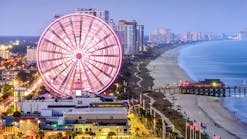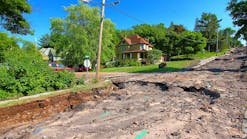About the author:
Winner profiles were compiled by SWS Managing Editor Katie Johns and Associate Editor Cristina Tuser. Johns can be reached at [email protected] and Tuser can be reached at [email protected].
Katie Johns & Cristina Tuser
undefinedEach year, the SWS editorial team seeks to honor the best projects from the year. These 10 projects highlight innovation in the storm water and erosion control industry. From watershed management to restoration, the following
projects required close collaboration between contractors, designers, owners, manufacturers and more to bring each project to completion. SWS thanks everyone who submitted projects this year, and we look forward to seeing the innovative projects that are nominated next year.
Location: Ma'alaea (Kihei), Hawaii (Island of Maui)
Cost: $613,158
Size: 5.268 acres (watershed area)
Owner: State of Hawaii Divison of Forestry and Wildlife, Spencer Family (currently, sale is pending to County of Maui)
Manager: Maui Nui Marine Resource Council
Designer: Maui Environmental Consulting & Goodfellow Bros
Contractor: Maui Environmental Consulting, Goodfellow Bros. & Sunshine Vetiver
Manufacturer: Eureka Water Probes & Goodfellow Bros.
In order to improve nearshore ocean water quality and the health of coral reefs in Maui’s Ma’alea Bay, the Vision for Pohakea Storm Water Management Project set out to reduce the transport of sediment via storm water runoff from the adjoining Pohakea Watershed.
However, that was not the only goal. The project also included installing firebreaks, a priority in the project, to suppress wildfires in the watershed; monitoring storm water runoff from several headcuts; utilizing the filter feeding abilities of more than 5,000 caged oysters in Ma’alaea Harbor to remove sediment from the water; continue monitoring ocean water quality in the Bay every three weeks year-round; and utilizing technology to generate additional data on the impaired water quality and establish solutions.
This project has been in the works since 2018, when the Maui Nui Marine Resource Council commissioned Maui Environmental Consulting to create the Pohakea Stormwater Management Plan. Ma’alaea Bay is home to various wildlife, including green sea turtles and humpback whales; a recreation area for surfers, boaters, fisherpeople and more; and Ma’alaea Harbor.
Overtime, sediment has become a major source of pollution and has contributed to the significant decline of the bay’s coral reefs. Part of the reason sediment is such an issue is due to the frequent wildfires that break out, which strip the land of the vegetation that holds soil in place. In December 2020, the firebreaks were installed to suppress wildfires, and hence, protect nearshore water quality.
In January 2020, the Maui Nui Marine Resource Council (MNMRC) installed the oysters, each of which can filter approximately 40 to 60 gallons of ocean water per day. Then, in early 2021, MNMRC’s monitoring of three headcuts revealed that 60,000 pounds of sediment were eroded and flowed into Ma’alaea’s coastal waters in just one moderate rainstorm. MNMRC is now working to repair those headcuts and writing grants to obtain proper funding. In fall 2021, MNMRC worked to plant drought-tolerant vetiver in the watershed, which will help hold soil on steeply sloped areas.
This project is ongoing, including one major step — the acquisition of a 257-acre parcel of the watershed that is on private property. The majority of the watershed is on state-owned land managed by the Hawaii Division of Forestry and Wildlife, so MNMRC worked with the DOFAW, Ma’alaea Village Association, Trust for Public Lands and the County of Maui to secure $5.5 million in funding in the 2022 Maui County budget for the purchase of the parcel.
Once that land is purchased, DOFAW can combine it with the 4,000 acres of the West Maui watershed to actively manage all lands to address wildfire and erosion into the bay.
“We are proud that this is a multi-faceted approach to address the issue of sediment run-off in Ma'alaea Bay: our work is in the water (our oyster bioremediation project) and on land (our work in Pohakea watershed). It is a model for other watersheds and impaired coastal areas of Hawaii,” said Anne Rillero, communications, community outreach and development manager for the Maui Nui Marine Resource Council.






